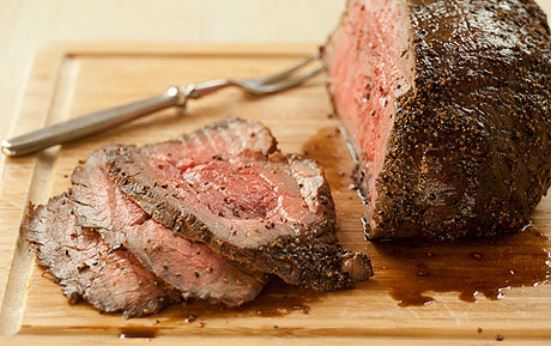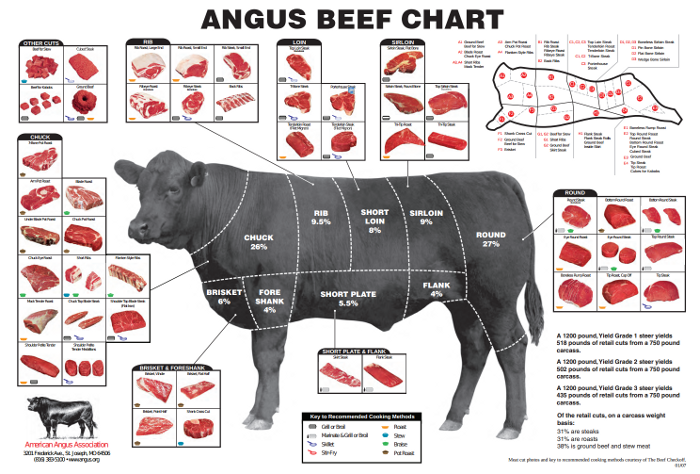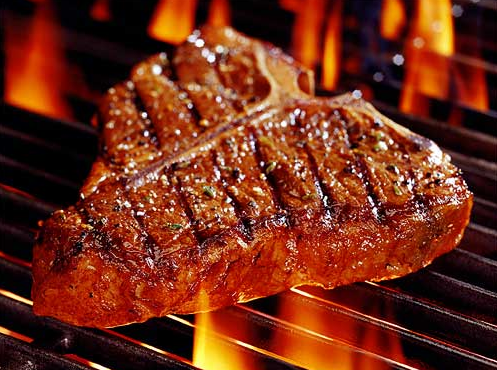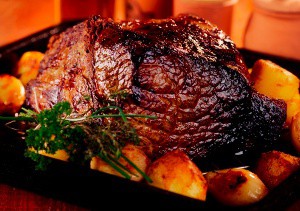What Are YOU Grilling?
A Guide to Cuts of Beef

My husband and I recently bought a freezer to supplement the tiny little fridge/freezer that comes with our apartment. I love to stock up on things when they are on sale, and it’s hard to do when you have about a cubic foot to work with! (Okay, it’s probably bigger than that- but it doesn’t feel like it!). With this new purchase, I have wanted to branch out with the meats I cook. I tend to stick to really basic- chicken breasts, ground beef, and occasionally boneless pork ribs if we are having a Café Rio copycat night. But I realized I know very little about meat. When it comes to buying different cuts and knowing which cooking method is best for particular cuts- I am totally lost. I thought I would share the results of my research with you, for those of you who may be as clueless as I am!
I found this incredible chart that breaks down the cuts of a cow, but also the recommended way to cook each cut. Rather than try to reword it, I thought I would include it for your convenience.

If you would like to see this information in a different layout, check out the first source listed (meatcosales.com). They also have charts for pork, lamb, and veal.
In a nut shell, the top part (or loin), is going to be the most tender. This is where all those yummy T-bone, Porterhouse and Top Sirloin steaks come from! These are the cuts that don’t require a lot of work because they are naturally more tender and flavorful.
The bottom of the cow is where the flank steaks are made from, and these are often used to make carne asada (for some delicious fajitas perhaps?).
The round section, found at the back of the cow, is usually cut into bigger pieces of meat, and they aren’t as tender as the loin. These cuts, such as boneless rump roast or eye round roast, are often used as roasts or put into stews to help them become a little more flavorful and tender.
Each animal is going to be a little different as to the type of cuts that are made, as well as which cuts are tender and which ones are tougher. When looking at cuts from pork and lamb- again, the top (loin) cuts are always going to be the most tender. However, with lamb the leg is also very tender, while pork sides (ribs), are tender.
Although there’s no meat police that will force you to cook your meat a certain way, there are certain cooking methods for particular cuts that will help you maximize the flavor and unique qualities of the cut you are using.

When cooking with a tender cut, such as top sirloin or T-bone steak, a grill or skillet is going to be your best friend. Because these cuts are so soft (and naturally very flavorful), you really don’t have to do much to make them more tender (and cooking them longer can ruin their natural tenderness). These cuts are perfect for your upcoming 4th of July BBQ!

When cooking with a tougher cut, such as a boneless rump roast, roasting or braising is the best method, as it helps to add flavor and can make them more tender.
This is by no means even close to a conclusive resource for all your meat cuts and how to cook them, but it’s a start! I would encourage you to branch out sometime this month and buy, cook, and eat a cut of meat that you haven’t tried before! And if you have any added tips or advice, I’d love to hear all about it!
- https://www.mmmsteak.com/
- https://www.buzzle.com/articles/how-to-cook-a-bottom-round-roast.html
- https://www.wholefoodsmarket.com/blog/whole-story/beef-roasts-everyday-and-holidays
- https://www.meatcosales.com/meat-cuts.html
- https://basketflatranch.com/cutting-instructions
- https://eat.snooth.com/articles/meat-it-ys-what-ys-for-dinner/
 Camille Hoffmann
Camille Hoffmann
Weekly Newsletter Contributor since 2014
Email the author! camille@dvo.com
